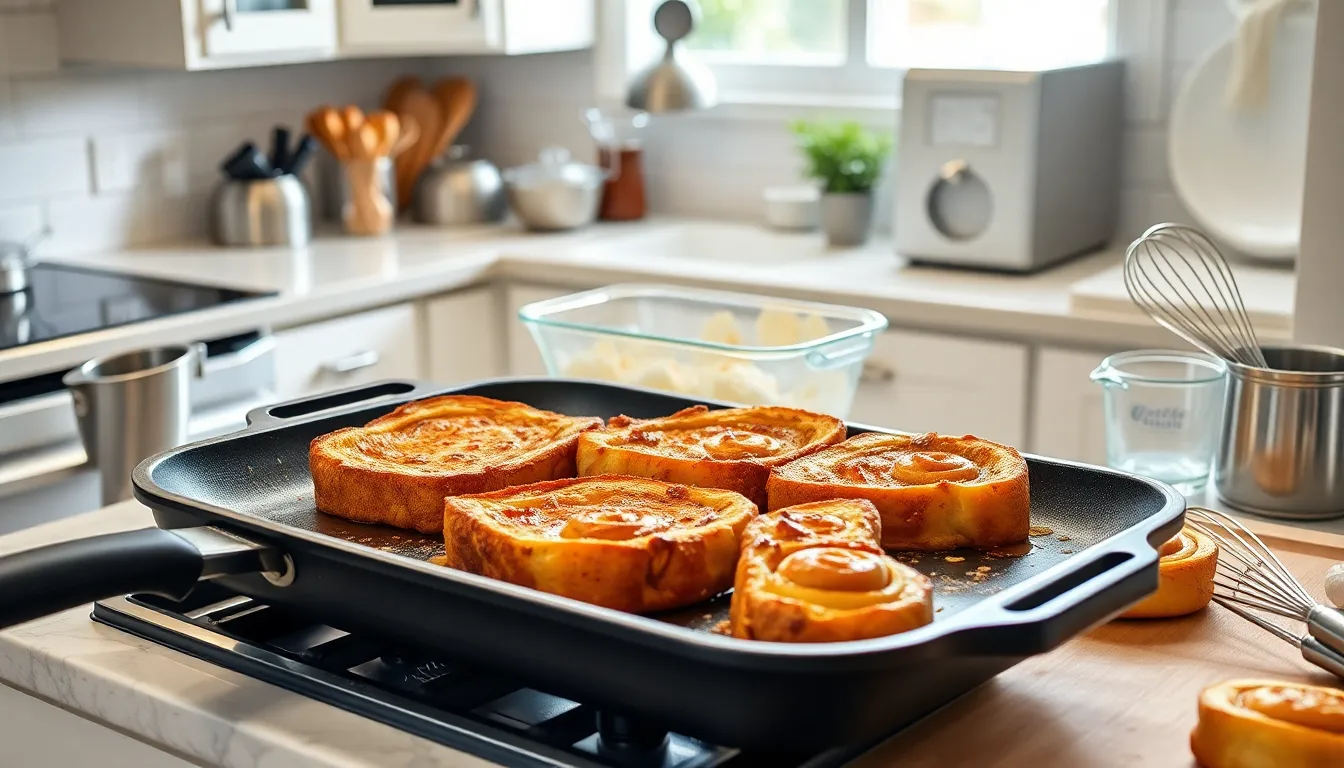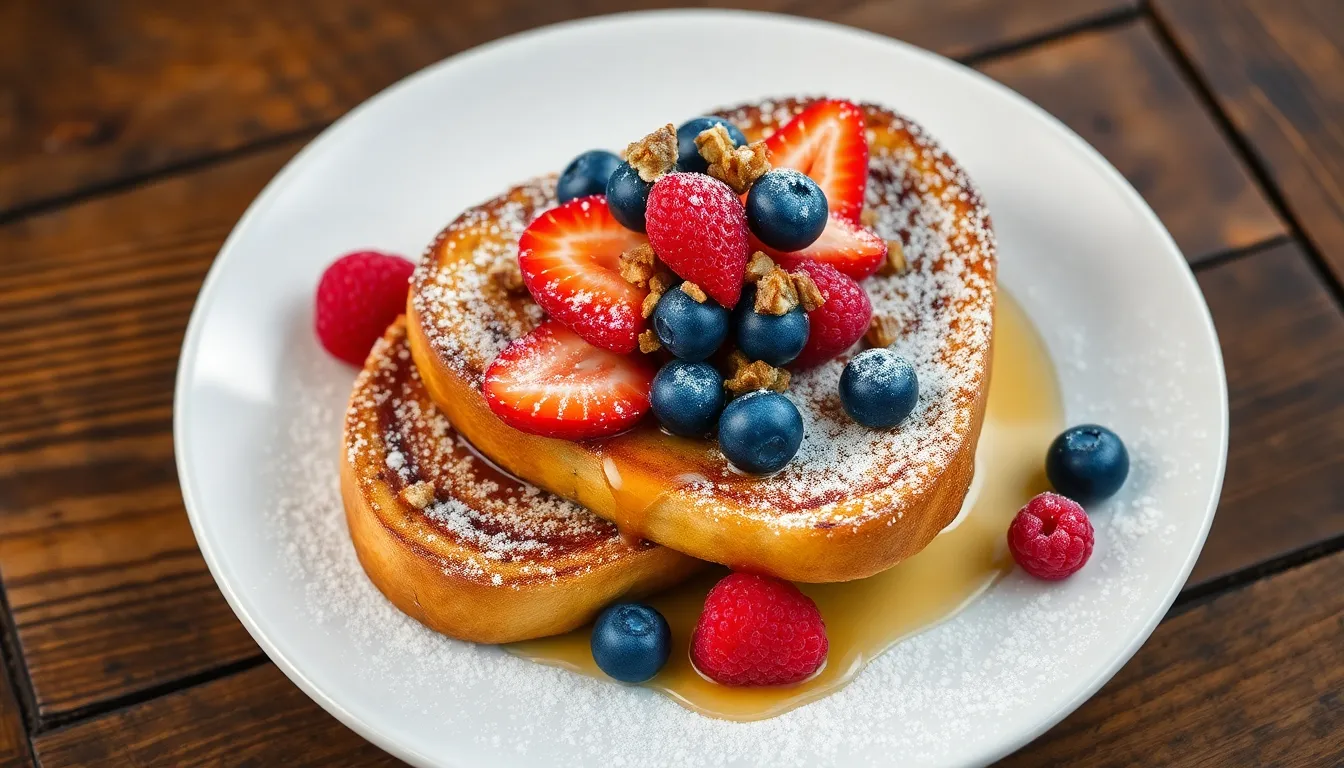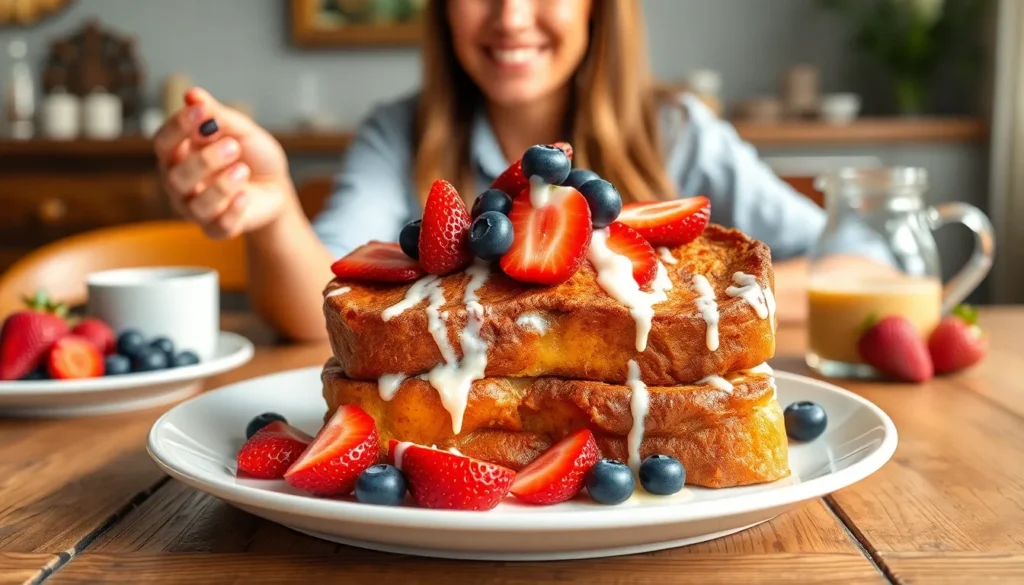We’ve all been there – torn between ordering cinnamon rolls or French toast at brunch. What if we told you there’s a way to have both in one incredible dish? Cinnamon roll French toast transforms ordinary breakfast into an extraordinary indulgence that’ll make your taste buds dance with joy.
This genius mashup takes everything we love about fluffy cinnamon rolls and combines it with the crispy-edged perfection of classic French toast. We’re talking about thick slices of cinnamon swirl bread soaked in rich custard then cooked to golden perfection. The result? A breakfast that’s crispy on the outside tender on the inside and bursting with warm cinnamon flavor.
Whether you’re hosting a special brunch or treating yourself to a weekend morning luxury this recipe delivers restaurant-quality results right from your own kitchen. Trust us – once you try this sweet twist on traditional French toast you’ll never look at breakfast the same way again.
Ingredients
Creating this indulgent breakfast masterpiece requires three distinct components that work together to deliver layers of cinnamon sweetness. Each element builds upon the last to create the perfect balance of flavors and textures.
For the Cinnamon Roll French Toast
- 8 thick slices cinnamon swirl bread (1-inch thick)
- 4 large eggs
- 1 cup whole milk
- 2 tablespoons heavy cream
- 2 tablespoons granulated sugar
- 1 teaspoon vanilla extract
- 1/2 teaspoon ground cinnamon
- 1/4 teaspoon salt
- 3 tablespoons butter (for cooking)
For the Cinnamon Sugar Coating
- 1/2 cup granulated sugar
- 2 teaspoons ground cinnamon
- 1/4 teaspoon nutmeg (optional)
For the Cream Cheese Glaze
- 4 ounces cream cheese (softened)
- 1 cup powdered sugar
- 3-4 tablespoons milk
- 1 teaspoon vanilla extract
- Pinch of salt
Equipment Needed

Making perfect cinnamon roll french toast requires the right tools to achieve that golden exterior and tender cinnamon swirl interior. We’ve compiled the essential equipment list to ensure your breakfast masterpiece turns out flawlessly every time.
For Casserole Style Preparation:
- 9×13 inch baking dish or casserole pan for the traditional baked version
- Oven preheated to 350°F (175°C) for even cooking
- Cooking spray or butter for greasing the pan
- Toothpick or cake tester to check doneness
For Individual Stovetop Servings:
- Large griddle or skillet for cooking individual pieces
- Spatula for flipping and removing cooked french toast
- Medium heat setting for golden brown results
Essential Preparation Tools:
- Measuring cups and spoons for accurate ingredient portioning
- Whisk or large mixing bowl to combine eggs, milk, and flavorings
- Cutting board and sharp knife to slice cinnamon rolls if needed
- Small bowl for mixing streusel or additional toppings
| Equipment Category | Primary Use | Size Recommendation |
|---|---|---|
| Baking Dish | Casserole style | 9×13 inch |
| Griddle/Skillet | Individual servings | Large capacity |
| Mixing Bowl | Egg mixture | Medium to large |
| Oven Temperature | Baking | 350°F (175°C) |
The equipment you choose depends on your preferred cooking method. Casserole style works beautifully for feeding a crowd and can be assembled the night before for convenient morning baking. Individual stovetop preparation gives you more control over each piece and delivers immediate results when you’re craving that perfect golden crust.
Instructions

Now we’ll walk through the step-by-step process to create this incredible breakfast dish. Follow these detailed instructions to achieve perfect cinnamon roll French toast every time.
Prep the Cinnamon Rolls
We begin by preparing our cinnamon rolls for the French toast transformation. Slice leftover or freshly baked cinnamon rolls in half horizontally to create two flat surfaces that will absorb the custard mixture effectively. For those using canned cinnamon rolls who prefer a casserole version, cut the rolls into smaller bite-sized pieces instead of slicing them horizontally.
Make the French Toast Batter
Our custard mixture forms the foundation of exceptional French toast. Whisk together eggs, milk, vanilla extract, and a touch of sugar and cinnamon in a large mixing bowl until completely smooth. For an extra rich version, substitute heavy cream for part of the milk to create a more decadent custard base. Beat the mixture thoroughly to ensure all ingredients are fully incorporated and no streaks remain.
Prepare the Cinnamon Sugar Coating
We create an optional but highly recommended cinnamon sugar coating for extra flavor depth. Mix granulated sugar and ground cinnamon in a small bowl using a 3:1 ratio of sugar to cinnamon. This coating adds another layer of sweetness and spice that complements the custard-soaked cinnamon rolls perfectly.
Cook the French Toast
Two cooking methods deliver excellent results depending on your preference and serving size needs.
Pan Method: Heat a nonstick skillet over medium heat and add butter to prevent sticking. Dip each cinnamon roll half into the custard mixture, allowing excess to drip off before placing in the hot pan. Cook for 2-3 minutes per side until golden brown and crispy on the outside while remaining tender inside.
Casserole Method: Preheat your oven to 375°F (190°C) for this crowd-friendly approach. Arrange the custard-soaked cinnamon roll pieces in your prepared baking dish and bake until the top is golden and the center is set.
Make the Cream Cheese Glaze
We finish our dish with a luxurious cream cheese glaze that ties all flavors together. Mix softened cream cheese with powdered sugar and a small amount of milk, whisking until the mixture becomes completely smooth and pourable. This creamy glaze adds richness and balances the cinnamon spice with its mild tanginess.
Serving Suggestions

We believe the beauty of cinnamon roll French toast lies in how easily you can customize each serving to create a restaurant-quality breakfast experience. Fresh fruit transforms our indulgent dish into a balanced meal that satisfies both sweet cravings and nutritional needs. Sliced strawberries bring vibrant color and natural sweetness that complements the cinnamon flavors perfectly. Raspberries add a delightful tartness that cuts through the richness of our cream cheese glaze. Blueberries burst with juicy sweetness in every bite while bananas provide creamy texture and natural sugars that enhance the overall flavor profile.
Brown sugar becomes our go-to topping when we want to amplify the sweetness and create caramelized notes that mirror traditional cinnamon roll flavors. Sprinkling this golden sweetener on top before serving adds depth and complexity to each forkful. Pure maple syrup elevates our cinnamon roll French toast to new heights with its rich amber flavor that soaks into every crevice of the bread. We recommend warming the syrup slightly before drizzling to ensure it flows beautifully over the surface.
Powdered sugar creates an elegant presentation that makes our breakfast look professionally prepared. Dusting this fine sugar over the finished dish provides a decorative finish that photographs beautifully and adds a subtle sweetness. Chopped pecans introduce a delightful crunch that contrasts wonderfully with the soft custard-soaked bread while contributing nutty flavors that pair naturally with cinnamon spices.
| Topping Type | Primary Benefit | Flavor Profile |
|---|---|---|
| Fresh Fruit | Adds nutrition and color | Sweet and tart balance |
| Brown Sugar | Enhances sweetness | Caramelized richness |
| Maple Syrup | Premium flavor upgrade | Rich amber sweetness |
| Powdered Sugar | Visual appeal | Subtle sweetness |
| Chopped Pecans | Textural contrast | Nutty crunch |
We find that combining multiple toppings creates the most satisfying breakfast experience. Our favorite combination includes fresh berries for freshness, a light dusting of powdered sugar for elegance, and a drizzle of warm maple syrup for that classic breakfast flavor. This approach ensures every bite delivers different textures and complementary flavors that make our cinnamon roll French toast memorable for any special occasion.
Storage and Reheating Tips

We understand that properly storing and reheating your cinnamon roll French toast ensures you can enjoy this delicious breakfast dish even after the initial preparation. Our storage methods preserve the dish’s texture and flavor while our reheating techniques restore that perfect balance of crispy exterior and tender interior.
Refrigerator Storage
We recommend storing leftover cinnamon roll French toast in an airtight container in the refrigerator for up to 3 days. This method prevents moisture loss and maintains the dish’s freshness by creating a controlled environment that protects against bacterial growth and flavor deterioration.
Freezer Storage
Our freezer storage method extends the life of your leftovers significantly. We transfer portions to airtight containers and store them in the freezer for up to 3 months. Before reheating frozen portions we always thaw them completely in the refrigerator overnight to ensure even heating.
Short-Term Room Temperature Storage
We occasionally store small amounts at room temperature when planning to consume them within 24 hours. Cover the dish tightly with plastic wrap though this method may cause some drying out compared to refrigerated storage.
Optimal Reheating Methods
Our reheating techniques restore the original texture and warmth of your cinnamon roll French toast:
| Reheating Method | Temperature | Time | Best For |
|---|---|---|---|
| Microwave | 30% power | 1 minute | Individual servings |
| Conventional Oven | 350°F | 5 minutes | Larger portions |
| Convection Oven | 325°F | 5 minutes | Crispy results |
| Air Fryer | Medium setting | 3-4 minutes | Quick reheating |
We prefer the microwave method for single servings using low power to prevent overcooking. For larger portions we use the oven at 350°F which restores the crispy exterior texture that makes this dish special.
Our air fryer technique provides excellent results for maintaining both texture and flavor during reheating. This method works particularly well when you want to restore that golden crispy surface without using the full oven.
Recipe Variations

We can transform our basic cinnamon roll French toast into exciting variations that suit different occasions and preferences. These adaptations offer unique textures and convenience options while maintaining the beloved cinnamon sweetness.
Overnight Cinnamon Roll French Toast
We prepare this make-ahead version using stale or day-old cinnamon rolls arranged in a greased 9×13 inch baking dish. Our custard mixture combines 6 eggs, 1 cup heavy cream, 1/2 cup milk, 1/4 cup granulated sugar, 1 teaspoon vanilla extract, and 1/2 teaspoon ground cinnamon. We pour this mixture over the cinnamon roll pieces, ensuring even coverage before covering with plastic wrap and refrigerating overnight.
The overnight soaking allows the custard to penetrate completely into the cinnamon rolls, creating incredibly tender results. We remove the dish from the refrigerator 30 minutes before baking to bring it to room temperature. Baking at 350°F for 35-40 minutes produces a golden top with a creamy interior that rivals any restaurant brunch dish.
Mini Cinnamon Roll French Toast Bites
We create these bite-sized treats by cutting refrigerated cinnamon rolls into quarters before the custard process. Our custard recipe remains the same, but we use a shallow bowl for easier dipping of the smaller pieces. Each mini bite gets fully coated in the egg mixture using tongs or a fork.
Cooking these miniature versions requires medium heat and careful attention since they cook faster than full-sized pieces. We arrange them in a single layer on our buttered skillet, cooking for 2-3 minutes per side until golden brown. These bite-sized portions work perfectly for parties, brunch buffets, or when we want portion control without sacrificing flavor.
We serve the mini bites on a platter with small bowls of our cream cheese glaze, maple syrup, and fresh berries for dipping. The smaller size makes them ideal finger foods that guests can easily customize with their preferred toppings.
Pro Tips for Perfect Results

We’ve discovered several key techniques that elevate cinnamon roll French toast from good to extraordinary. These professional tips ensure consistent results every time you make this indulgent breakfast.
Choose the Right Cinnamon Rolls
We recommend using day-old or leftover baked cinnamon rolls for the best texture. Fresh cinnamon rolls work too, but they should be cooled completely before cutting. Refrigerated cinnamon rolls offer excellent convenience and hold their shape well during cooking. Cut thicker cinnamon rolls in half to ensure even cooking and prevent burning on the outside while remaining raw inside.
Master the Soaking Technique
We soak each cinnamon roll piece for just a few seconds on each side to achieve optimal absorption. The custard should penetrate the surface without making the rolls soggy. Thicker pieces need slightly longer soaking time, while thinner slices require minimal contact with the egg mixture. This careful timing prevents the rolls from falling apart during cooking.
Control Your Cooking Temperature
We maintain medium heat when pan-frying to create a crispy exterior and fluffy interior. High heat burns the outside before the center cooks through. For casserole-style preparation, we bake at 375°F to ensure the egg custard sets properly without overcooking the cinnamon rolls. Lower temperatures result in soggy texture, while higher temperatures create uneven cooking.
Layer for Casserole Success
We arrange cinnamon roll pieces in a single layer when making casserole-style French toast. Overlapping pieces cook unevenly and create soggy spots. Pour the egg custard mixture evenly over all pieces, ensuring each roll receives adequate coverage. This technique guarantees uniform cooking and consistent flavor throughout the dish.
Keep Servings Warm
We place cooked French toast in a 200°F oven to keep it warm when serving a crowd. This prevents the first pieces from getting cold while finishing the remaining batch. Individual pieces maintain their crispy texture better than stacking them on a plate. Cover with foil if holding for more than 10 minutes to prevent drying out.
Optimize Your Equipment Setup
We use a large griddle or skillet for stovetop cooking to accommodate multiple pieces simultaneously. A 9×13 inch baking dish works perfectly for casserole preparation, providing adequate space for proper heat circulation. Having the right equipment ready before starting ensures smooth cooking and prevents overcooking while switching between batches.
Conclusion
We’ve shared everything you need to transform your breakfast game with this incredible Cinnamon Roll French Toast recipe. From the essential techniques to creative variations this dish offers endless possibilities for delicious mornings.
Whether you’re hosting a special brunch or treating yourself to a weekend indulgence you now have all the tools and knowledge to create restaurant-quality results at home. The combination of crispy exteriors tender interiors and that irresistible cinnamon sweetness makes every bite worth the effort.
Don’t forget to experiment with our suggested toppings and variations to make this recipe uniquely yours. Your family and friends will be asking for this show-stopping breakfast creation again and again.
Frequently Asked Questions
What is Cinnamon Roll French Toast?
Cinnamon Roll French Toast is a decadent breakfast dish that combines thick slices of cinnamon swirl bread soaked in a rich custard mixture and cooked to golden perfection. It features a crispy exterior and tender interior filled with cinnamon flavor, creating a restaurant-quality breakfast experience that’s perfect for special occasions or weekend treats.
What ingredients do I need for Cinnamon Roll French Toast?
The main ingredients include thick cinnamon swirl bread slices, eggs, whole milk, heavy cream, granulated sugar, vanilla extract, ground cinnamon, salt, and butter for cooking. You’ll also need ingredients for the cinnamon sugar coating and cream cheese glaze to complete this indulgent breakfast dish.
Can I make Cinnamon Roll French Toast ahead of time?
Yes! The Overnight Cinnamon Roll French Toast variation allows you to soak cinnamon rolls in the custard mixture overnight in the refrigerator. This make-ahead method results in incredibly tender French toast and is perfect for busy mornings or when entertaining guests.
How do I store leftover Cinnamon Roll French Toast?
Store leftovers in an airtight container in the refrigerator for up to 3 days or freeze for up to 3 months. For reheating, use a microwave for individual servings, conventional oven for larger portions, or air fryer to maintain the crispy exterior and tender interior.
What are the best toppings for Cinnamon Roll French Toast?
Popular toppings include fresh berries (strawberries, blueberries, raspberries), pure maple syrup, powdered sugar, brown sugar, and chopped pecans. The recommended combination is fresh berries, powdered sugar, and warm maple syrup for a balanced and memorable breakfast experience.
What equipment do I need to make this recipe?
For casserole style, you’ll need a 9×13 inch baking dish and an oven preheated to 350°F. For stovetop preparation, use a large griddle or skillet with medium heat. The choice depends on whether you’re serving a crowd (casserole) or want individual control (stovetop).
How do I prevent my French toast from getting soggy?
Use day-old or cooled cinnamon rolls for optimal texture and avoid over-soaking the bread. Master the soaking technique by allowing just enough time for the custard to penetrate without making the bread mushy. Cook on medium heat to ensure proper cooking throughout.
Can I make mini versions of this recipe?
Yes! The Mini Cinnamon Roll French Toast Bites variation uses refrigerated cinnamon rolls cut into quarters, creating bite-sized treats perfect for parties or brunch buffets. This variation maintains the beloved cinnamon sweetness while offering convenient portion sizes for entertaining.







